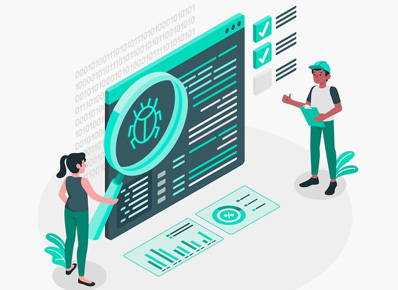One of the biggest aims of an organization is optimizing customer satisfaction in order to grow. To achieve this, various techniques are used. The A/B testing is an important technique used for data driven product development that has been proved to be useful in the organizations working in the online webspace. We have tried to study and identify the benefits and challenges of using A/B testing and suggest a few ideas to overcome the challenges in this method.
A/B Testing Introduction:
A/B testing is a well-studied comparison problem with two samples whose goal is to estimate the difference between the treatment effects of different variations. The effect of a new feature is measured by exposing it to a very small randomly selected proportion of the user population. In most of the A/B tests, the aspects that are visible to the user are such as the front-end of the applications, fonts, layouts, and colors are given more importance.
History of A/B Testing:
The A/B testing dates back in the 1700s. A British ship captain observed that the sailors were healthier when sailing to the Mediterranean countries, where fruits were easily accessible. Based on this, he distributed limes to half of his crew while the rest of the crew continued with the regular diet. With this experiment, the captain found out that the sailors should consume citrus fruits to stay healthier while on a voyage. This is one of the early examples of A/B testing, where a crew on a citrus diet is represented as A and the rest with a regular diet are represented as B which sums up to a comparison problem.
A/B testing became fully developed in 2016 as a result of the modification of the web optimization and experimental tools.
Lifecycle of A/B testing:
We can test many things through A/B testing, but what needs to be tested in the application is very important.
The lifecycle of A/B testing can be conducted by the following steps:
⦁ Pick one variable to test: A few best practices to determine the independent variable would be to consider the elements in the marketing resources and possible alternatives for design, layout, and wording.
⦁ Identify the goal: Even though we have different metrics in a test, it is significant to choose primary metrics before we perform A/B testing. We have to determine where the dependent variable needs to be in the split test and also need to state a hypothesis and then examine the results based on prediction.
⦁ Create control and challenger: The next step to consider after having both the dependent and the independent variable, is using the result to create a “controlled” unaltered structure to test.
⦁ Split your sample groups equally and randomly: There needs to be more than two audience groups for test operations where you have control over the audience, in order to have absolute results.
⦁ Determine the sample size: Running a test for a longer period and the length of time you keep the test running will be the deciding factor for creating the sample size.
⦁ Decide how significant your results need to be: The percentage of the confidence level is directly proportional to the assurance of the results. Usually, a minimum confidence level of 95% is expected.
⦁ Give the A/B test enough time to produce useful data: Duration of testing time cannot be categorically determined, it solely depends on the individual company and how they execute the A/B test.
⦁ Feedback from users: Even if A/B testing is good it does not replace real feedback from real users. It is important to keep the feedback channels open and continue talking to users and understand how they use the application and what they would prefer and so on.
⦁ Take actions based on the results: If we can find one variation as statistically better than the other, then there is a winner. Therefore, we can disable the losing variation in your A/B testing tool.
Benefits of A/B testing:
A/B testing helps to compare one or more versions of a designed service experience, and helps to understand more about the user’s needs. Some benefits include higher user engagement, a spike in the customer conversion rate, decreased bounce rate, benefits in analysis, better content marketing, decreased cart abandonment, and risk mitigation.
Challenges of A/B testing:
This is a customer or user-centric model, where the test is conducted on abstract notions. The tests that run on UI changes, recommendation algorithms take weeks to clear the effects on user behavior. Small sample size, biased sample data, creating the test designs that are producing statistically significant results. Designing A/B tests in these scenarios can be challenging because of the content-specific interactions and continuous validations on diverse content and devices.
Few challenges and how they can be resolved:
Failure of experiments is at a higher rate. To overcome this, a database of items tested and the learnings from the failure help gain experience in selecting the most probable test item. Observations help in building Scientific methods of gathering information on an idea, making it easier for upcoming experiments.
Tests on recommendations and UI related tests take a lot of time to derive conclusions. Real-time allocation approach causes slowness. Hence, randomization is not possible. Quasi Experiments and Causal Inference techniques are used in these cases.
The iterations are higher in certain conditions. So the number of iterations required to reach a goal can be reduced by adopting Response Surface Methodology which is only an approximation, but we still use it to make it easy to estimate and apply.
Conclusion
A/B testing is used by a wide range of companies and it has become a widely used practice. The decision of modifying things in a software or design tool is now recognized using A/B testing. It has become a critical tool for the abstract decisions in the product life cycle. It has made testing and experimentation to improve scale the process and enables quick evaluation of such ideas.

